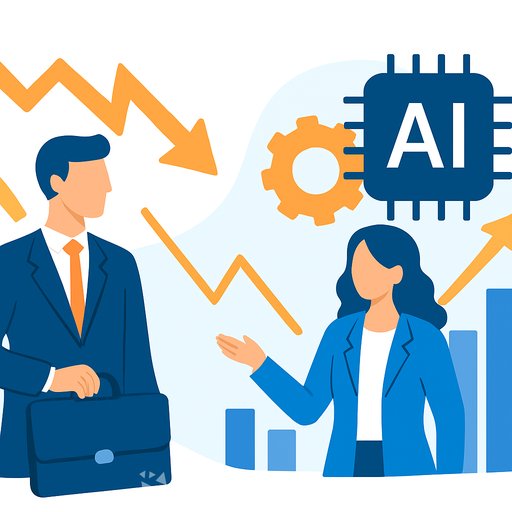AI Strategy: Why Energy CEOs Must Reinvent for the AI Era
Here's the hard signal: 40% of leaders in energy, utilities and resources say their businesses won't be viable in a decade if they stay the course. That's not forecasting - that's an expiration date.
Pushing against the old model are three forces: AI adoption, sustainability requirements, and geopolitical pressure. Together they're rewriting how value gets created, captured, and defended.
What the PwC data actually says
Pwc's 28th Annual Global CEO Survey shows a sector split between incumbents tied to legacy processes and leaders leaning in. One-third of CEOs already report Gen AI has lifted revenue and profitability in the past year.
The numbers are specific: 56% say Gen AI improved how employees use their time; 32% saw revenue up; 34% saw profitability up; and 49% still expect Gen AI to increase profitability over the next 12 months. Headcount isn't a one-way story either - 13% reduced roles linked to Gen AI, while 17% added roles.
The red flag: nearly half of CEOs prioritise integrating AI into platforms and workflows over the next three years, but only one-third plan to embed AI into workforce and skills strategies. Technology without talent is shelfware.
Reinvention now, or margin erosion later
Maxim Vykhovanets, Country Managing Partner and Energy, Utilities & Resources Leader at PwC in Ukraine, is direct: the need for reinvention will intensify - bringing both risks and fresh opportunities. Technology is the catalyst: automation, AI, and advanced manufacturing can lift productivity at a time the sector needs it most.
He adds that improving sustainability and circularity isn't just compliance. It's a lever for resilience and new value pools.
Climate action is paying off
The survey shows climate-friendly investments deliver. In EUR sectors, 17% report reduced costs, while 37% report increased revenues. Across industries, these bets were six times more likely to boost revenue than reduce it.
Investors are aligned: nearly 70% believe companies should invest in sustainability even if it dents short-term profit. That makes this less of an ESG debate and more of a capital allocation decision.
Geography matters. Roughly half of CEOs in Germany and France report higher costs from climate investments versus only one-fifth in the US. In Mainland China, 60% report higher revenues and 46% benefit from incentives - a different equation entirely.
The pattern behind stronger margins
Pwc's data connects deeper reinvention with better profit margins. The companies pulling ahead are rethinking business models, not just deploying tools. Most have made moves; few have made the hard shifts that compound.
Your 12-month reinvention plan
Here's a practical agenda you can brief to the board and your ELT.
- Days 0-90: Focus on value, not pilots
- Pick 3-5 AI use cases tied to cash outcomes (OPEX, throughput, working capital, safety).
- Stand up a cross-functional "AI value office" with P&L, ops, data, risk, and HR.
- Fund a dedicated data pipeline for those use cases; don't boil the ocean.
- Set guardrails: model risk review, privacy, cyber, and human-in-the-loop criteria.
- Define success metrics upfront: payback period, EBITDA lift, tCO2e per MWh, asset uptime.
- Months 3-6: Build into the workflow
- Integrate AI into SCADA, ETRM, ERP, and field service workflows - not side tools.
- Create skills pathways for ops, maintenance, trading, and corporate functions.
- Tie KPI changes to incentives: time-to-decision, forecast accuracy, unplanned downtime.
- Launch FinOps for AI to track unit economics (inference cost per decision, data spend).
- Months 6-12: Scale and harden
- Refactor playbooks into reusable components (prompts, data products, evaluation packs).
- Adopt a product operating model for data/AI with named owners and SLAs.
- Expand into revenue-side plays: dynamic pricing, DER orchestration, new service bundles.
- Advance climate ROI: carbon-aware dispatch, circular asset management, methane abatement analytics.
- Use M&A and partnerships to fill capability gaps (models, sensors, edge compute).
Where AI is already moving the needle
- Predictive maintenance for turbines, compressors, and grid assets (downtime and parts spend).
- Demand forecasting and bid optimisation for trading and market operations.
- Field force augmentation: work-pack generation, procedure guidance, and QA.
- Back-office automation: contracts, compliance, finance close, and procurement.
- Safety and emissions monitoring from imagery, telemetry, and acoustic data.
Sustainability as a profit center
- Rework portfolios for cash and carbon: divest low-return, high-intensity assets; scale profitable low-carbon lines.
- Price carbon into every investment case and vendor contract.
- Build circularity programs for high-value components and critical minerals.
- Monetise data: share verifiable emissions and performance data with customers and regulators.
Governance and risk that won't slow you down
- Board-level AI and climate oversight with a clear risk appetite and escalation path.
- Model lifecycle management: data lineage, evaluation, drift monitoring, incident response.
- Third-party due diligence for foundation models and data vendors.
- Scenario planning for supply chain shocks and policy shifts, with triggers for capital reallocation.
Metrics your CFO and COO will respect
- EBITDA lift attributable to AI and sustainability programs.
- Forecast accuracy (load, price, production) and time-to-decision.
- Asset uptime, maintenance cost per unit, and safety incident rate.
- tCO2e per MWh, methane intensity, and % revenue from low-carbon products.
- Unit economics of AI: cost per inference, AI-assisted hours saved, error rates.
Talent and capability building
Technology ambition without workforce planning is where programs stall. Create role-based skill paths, a certification plan, and on-the-job learning loops for operators, engineers, traders, and corporate teams.
If you need a starting point for structured upskilling, explore role-based AI curricula here: Complete AI Training - Courses by Job.
The decision in front of you
You can wait for clarity or create it. The companies pulling away are choosing focused reinvention: a few high-value AI bets, sustainability that pays back, and an operating model that learns fast.
The window is open - and it won't stay that way for long.
Your membership also unlocks:






